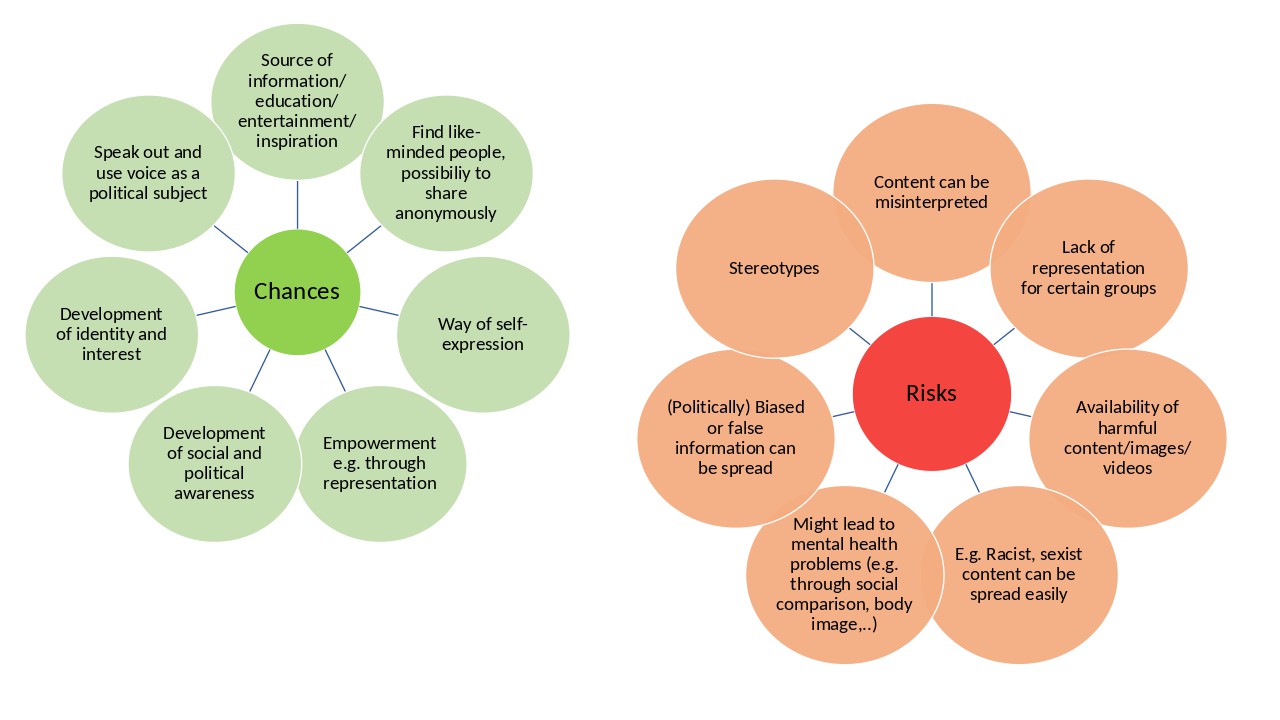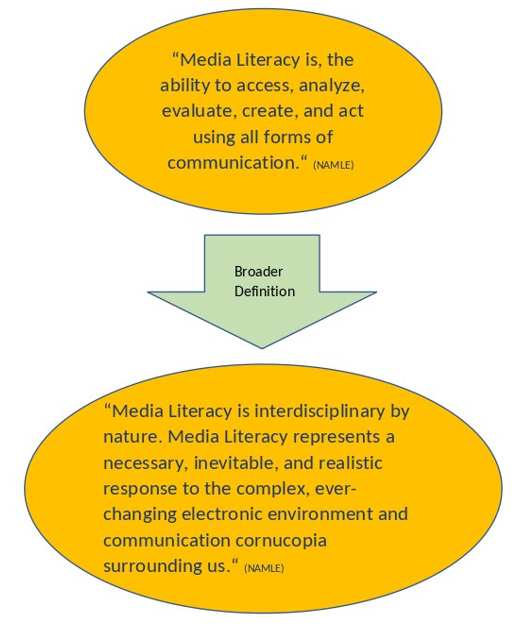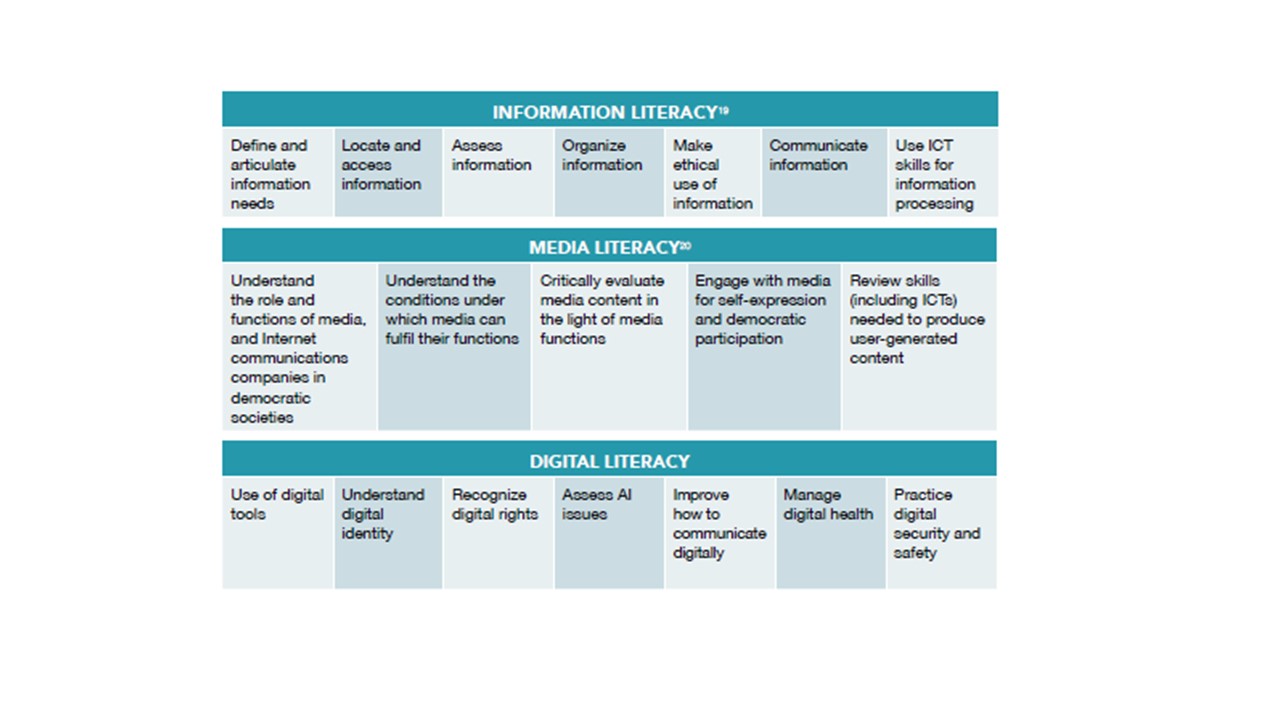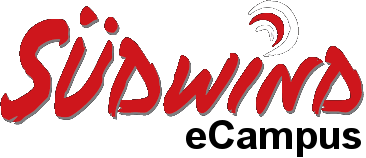الخطوط العريضة للقسم
-
Welcome to the second module.
In this module you will
- get to know the multi-discliplinary approach of Media Literacy and why it is important for education
- find out how to integrate Media Literacy in your teaching practice
- raise awareness of the reproduction of social inequalities and stereotypization in and by media
- reflect your own teaching practice
-

-
1. The Role of Media in Society
Media surrounds us every day - online and offline, it means printed newspapers, commercials, magazines, the internet, social media content, apps, messengers, networks, books, radio, television and so on. Our daily life is full with media and there is hardly any possibility to escape.
Nowadays, digital media contents gain more and more importance. This brings along new challenges, as well as new opportunities. Have a closer look on the image below. It is only a brief enumeration of challenges and opportunities of media - especially in the digital form. Is there anything more you could think of?

Figure 2: Chances and risks that digital media brings
-
2. What is Media Literacy?
 Figure 3: Definition of Media Literacy [1]
Figure 3: Definition of Media Literacy [1] -
Media Literacy Education
-
´To become a successful student, responsible citizen, productive worker, or competent and conscientious consumer, individuals need to develop expertise with the increasingly sophisticated information and entertainment media that address us on a multi-sensory level, affecting the way we think, feel and behave.´ [1]
-
Watch this video to see how other teachers incorporate media literacy into their teaching [2].
PBS Teachers | 5 Core Components of Media Literacy (2:50 Min):
The video is only available in English. Subtitles can be turned on on YouTube. The video presents teachers who explain how they integrate the five core components to media literacy: Access, Analyze, Evaluate, Create and Act into their classroom to teach media literacy.
-

Reflection
Read the two documents below to refresh your knowledge about the components of media literacy.
Compare your students´ favourite kinds of media with your own. Are there any differences?
-
Refresh your understanding of Media Literacy by reading this short overview written by NAMLE
-
Read about the Core Principles of Media Literacy (developed by NAMLE) here.
-

Reflection
According to NAMLE Media Literacy is made up of 5 components:
Access, Analyse, Evaluate, Create, Act
Think about your own interaction with media. Do you always follow the instructions on how to deal critically with media content? -
More projects that deal with handling media:
Nemo Toolkit (great practice to reflect on media), Hatebusters´ guide (guideline to work with adolescents), Together (workshop focussing on youth work), nohatespeech (no hate speech gallery - being active against hatred)
-
Media and Information Literacy (MIL)
For a better understanding of the distinction between media and digital literacy, see the image below.
There are more and more publications talking about ´Media and Information Literacy´. This term combines information, media and digital literacy.
-

Figure 4: Key Outcomes/Elements of Media and Information Literacy [5]
-
Task 2:
You've now learned a lot about digital and media literacy. But what does all this have to do with inclusion?
Watch the following video and pay more attention to where you perceive representation in the media over the next few days.Why Representation Matters
In this TED Talk Aisha Thomas challenges us to imagine a world where all races are represented in all aspects of life. Where children grow up with a sense of value, connection and understanding of difference [6].
Why Representation Really Matters | Aisha Thomas | TEDxBristol (13:47 Min):
The video is only available in English. Subtitles can be turned on on YouTube.
-
Sources
[1] National Association for Media Literacy Education. (2021, 10. Februar). Media Literacy Defined. NAMLE. https://namle.net/resources/media-literacy-defined/
[2] PBS LearningMediaTM. (2019, 25. Oktober). PBS Teachers | 5 Core Components of Media Literacy [Video]. YouTube. Abgerufen am 7. Februar 2023, von https://www.youtube.com/watch?v=oDCuKpzXeaE
[3] National Association for Media Literacy Education. (o.D.) Media Literacy!. NAMLE.
[4] National Association for Media Literacy Education. (2021b, Dezember 21). Core Principles. NAMLE. Abgerufen am 7. Februar 2023, von https://namle.net/resources/core-principles/
[5] Nilsson, O. (2021, 12. Oktober). MIK 2.0 – Unescos ramverk uppdaterat! Digiteket. https://digiteket.se/inspirationsartikel/mik-2-0-unescos-ramverk-uppdaterat/
[6] TEDx Talks. (2020, 6. Februar). Why Representation Really Matters | Aisha Thomas | TEDxBristol [Video]. YouTube. https://www.youtube.com/watch?v=-X-taPvKWbY
